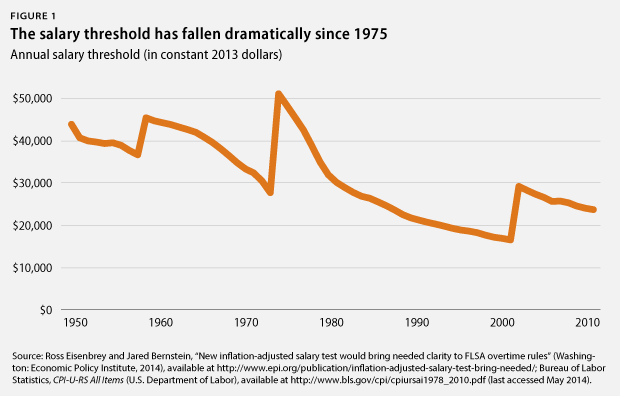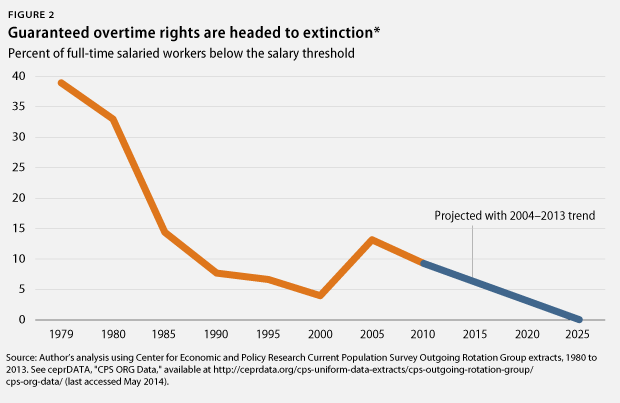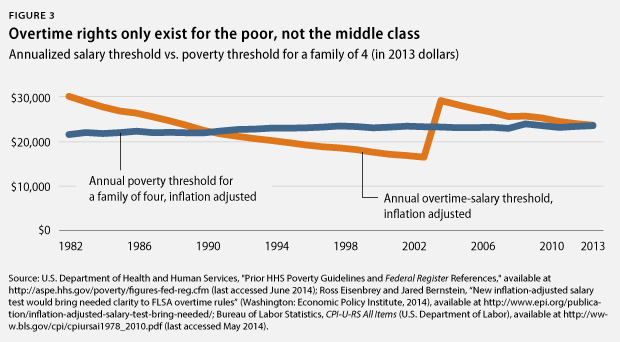This issue brief contains a correction.
For the past 30 years, middle- and working-class families have been squeezed as the cost of living rises faster than their incomes. More and more families are struggling and are living paycheck to paycheck.
Americans could once boost their paychecks by boosting their hours at work because federal overtime rules guaranteed them time-and-a-half pay for hours worked beyond 40 hours per week. But only 8 percent of full-time salaried workers have guaranteed overtime rights today. If current trends continue, no salaried workers will qualify for guaranteed overtime by 2026.* For many Americans, it is simply no longer the case that if one works harder and longer, he or she will be rewarded.
Fortunately, the Obama administration recently instructed the U.S. Department of Labor to modify federal overtime-eligibility rules, including the “salary threshold”—the amount of weekly earnings a salaried worker has to earn before he or she no longer qualifies for guaranteed overtime rights.* Modernizing overtime rules would restore the basic American promise that workers who work extra hard deserve extra pay.
This issue brief finds that:
- The overtime-salary threshold’s real value has declined by more than half since its peak in 1975. Part of this is because of the failure to adjust it for inflation, but it is also because of a radical rule change in 2004 that placed the overtime-salary threshold at just $455 per week—well below previous threshold changes in real terms, which were at least $800 per week in inflation-adjusted dollars and above the average wage.
- The inadequate 2004 overtime-threshold change and the failure to raise it since have placed overtime rights on the brink of extinction: 33 percent of full-time salaried workers’ salaries guaranteed them overtime rights in 1980. Today, this is true for only 8 percent of them. No salaried workers will have guaranteed overtime rights by 2026 if current trends continue.*
- The current salary threshold of slightly more than $23,600 essentially equals the federal poverty threshold. By definition, the right to overtime pay for overtime work no longer exists for the American middle class.
- The Department of Labor should raise the salary threshold to at least $960 per week—approximately $50,000 per year—roughly its 1975 level. U.S. real gross domestic product, or GDP, and worker productivity have only grown since the 1970s, and as a result, we can well afford to grant workers the same overtime rights that they had in 1975.
The salary threshold: The only guarantee of extra pay for extra work
The Fair Labor Standards Act, or FLSA, of 1938 established the first federal minimum wage and required that employers pay overtime—1.5 times the hourly wage for any work beyond 40 hours per week—with an exemption for managerial and administrative staff. The FLSA gives the Department of Labor the power to define who is overtime exempt, a power it has exercised a total of six times.
Today’s basic overtime-eligibility framework dates back to 1950. Overtime-exempt employees must make more than a certain amount per week—the salary threshold—and then must satisfy a duties test, which is a set of managerial, administrative, or professional tasks that an employee must perform, such as supervising other workers and exercising independent judgment. Contrary to popular belief, overtime rules apply just as much to salaried workers as they do to hourly workers. If an employee’s fixed salary falls below the salary threshold or the employee does not meet the duties test for overtime exemption, then the employer must pay the salaried worker 1.5 times the hourly wage for work that exceeds 40 hours per week.
In 2004, the Bush administration modified the overtime rules by raising the salary threshold and changing the duties test. Both employee and employer groups criticized the new duties test because it obscured which workers were overtime exempt. The U.S. Chamber of Commerce’s director of labor policy at the time called the rules “so complicated, even the best-intentioned employer has a hard time being in compliance.”
It is easy to see why. An employer can classify a front-line retail supervisor or fast-food assistant manager as an exempt “executive” as long as he or she has the “primary duty of managing”—no percentage breakdown is given—supervises at least two employees, and the employer considers his or her personnel suggestions. This so-called executive may spend most of his or her time stocking shelves or taking orders while actually earning less than the minimum wage on an hourly basis because he or she works 60 hours per week on a fixed weekly salary.
The ease with which employers can—intentionally or not—misclassify workers through the duties test makes the salary threshold the only way to guarantee workers the right to extra pay for extra work.
The salary threshold’s infrequent updates and the Bush administration’s inadequate update
Unfortunately, these guaranteed overtime rights have performed an extraordinary disappearing act over the past three decades. The salary threshold has never been linked to inflation, and the Department of Labor has raised it only a total of three times since 1950. (see Table 1 in the PDF) Irregular threshold raises—and one inadequate raise—have caused its current value—$23,660—to be less than half of its 1975 value—$51,177—even though American workers are more productive and work longer hours today.

Despite their irregularity, salary-threshold raises have traditionally placed the annual salary threshold above $800 per week in inflation-adjusted dollars, or approximately $41,600 per year. They have also guaranteed overtime rights for a large portion of middle-class workers, since the raises placed the threshold well above the average wage, as Table 1 shows. For example, the 1975 threshold raise protected overtime rights for workers who made 32 percent more than the average wage.
The 2004 Bush administration threshold change was historic for two reasons: It was the first update since 1975, and it was the first update to place the threshold below the average wage. Both Democratic and Republican administrations had consistently put the salary threshold between $44,000 and $51,000 per year in inflation-adjusted dollars. But the Bush administration put the salary threshold at only $29,178, 28 percent below the 2004 average wage.
Overtime rights on the brink of extinction
The Bush administration’s rule change represented a radical and inadequate redesign of the salary threshold. The failure to raise the threshold since has deprived even more Americans of critical overtime rights, as demonstrated in Figure 2. Today, only 8 percent of full-time salaried workers have guaranteed overtime rights—down from 33 percent in 1980.*

The disappearance of overtime rights shows no signs of stopping, let alone reversing. If the Department of Labor does not modernize the threshold, no salaried workers will have a guaranteed right to overtime pay by 2026.* With overtime rights on the brink of extinction, opposition to modernizing the threshold is in opposition to the very concept of extra pay for extra work.
Guaranteed overtime rights have already entirely disappeared for the middle class. The annual wage of a 40-hour-per-week worker making the salary threshold of $23,660 now essentially equals the federal poverty-level income for a family of four—$23,550. Furthermore, the Census Bureau’s more accurate 2011 supplemental poverty measure of $25,222 for a family of four already stood above the salary threshold. By definition, the right to overtime pay for overtime work no longer exists for the middle class.

Conclusion
The Department of Labor should raise the salary threshold to at least $50,000, approximately its 1975 value. Over the past four decades, U.S. real gross domestic product has grown threefold, productivity is 80 percent higher, and the average worker works 11 percent more hours than he or she did in 1975. If we as a nation could afford the overtime rights then, we can afford them now.
The current overtime-salary threshold makes a mockery of traditional American notions of work and success, as working harder and putting in extra hours no longer means extra pay for middle-class Americans. Modernizing the salary threshold and extending guaranteed overtime rights to middle-class workers would restore basic principles of fairness to the labor market. A decision not to raise the threshold is a decision to let guaranteed overtime rights continue their march toward extinction.
Brendan V. Duke is a Middle-Out Policy Analyst at the Center for American Progress.
* Correction, November 17, 2014: This issue brief has been corrected to reflect the fact that most employees paid on an hourly basis have guaranteed overtime rights.